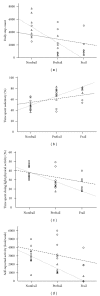Physical Activity across Frailty Phenotypes in Females with Parkinson's Disease
- PMID: 22919489
- PMCID: PMC3420090
- DOI: 10.1155/2012/468156
Physical Activity across Frailty Phenotypes in Females with Parkinson's Disease
Abstract
Females with Parkinson's disease (PD) are vulnerable to frailty. PD eventually leads to decreased physical activity, an indicator of frailty. We speculate PD results in frailty through reduced physical activity. Objective. Determine the contribution of physical activity on frailty in PD (n = 15, 65 ± 9 years) and non-PD (n = 15, 73 ± 14 years) females. Methods. Frailty phenotype (nonfrail/prefrail/frail) was categorized and 8 hours of physical activity was measured using accelerometer, global positioning system, and self-report. Two-way ANCOVA (age as covariate) was used to compare physical activity between disease and frailty phenotypes. Spearman correlation assessed relationships, and linear regression determined associations with frailty. Results. Nonfrail recorded more physical activity (intensity, counts, self-report) compared with frail. Self-reported physical activity was greater in PD than non-PD. In non-PD, step counts, light physical activity time, sedentary time, and self-reported physical activity were related to frailty (R = 0.91). In PD, only carbidopa-levodopa dose was related to frailty (r = 0.61). Conclusion. Physical activity influences frailty in females without PD. In PD females, disease management may be a better indicator of frailty than physical activity. Further investigation into how PD associated factors contribute to frailty is warranted.
Figures


Similar articles
-
Daily electromyography in females with Parkinson's disease: a potential indicator of frailty.Arch Gerontol Geriatr. 2014 Jan-Feb;58(1):80-7. doi: 10.1016/j.archger.2013.08.008. Epub 2013 Aug 27. Arch Gerontol Geriatr. 2014. PMID: 24063869
-
Concurrence of Frailty and Parkinson's Disease.J Frailty Aging. 2012;1(3):123-7. doi: 10.14283/jfa.2012.20. J Frailty Aging. 2012. PMID: 27093200
-
Frailty and Prodromal Parkinson's Disease: Results From the HELIAD Study.J Gerontol A Biol Sci Med Sci. 2021 Mar 31;76(4):622-629. doi: 10.1093/gerona/glaa191. J Gerontol A Biol Sci Med Sci. 2021. PMID: 32761172
-
Frailty in Parkinson's disease: A systematic review and meta-analysis.Clin Park Relat Disord. 2021 May 25;4:100095. doi: 10.1016/j.prdoa.2021.100095. eCollection 2021. Clin Park Relat Disord. 2021. PMID: 34316672 Free PMC article. Review.
-
Does levodopa slow or hasten the rate of progression of Parkinson's disease?J Neurol. 2005 Oct;252 Suppl 4:IV37-IV42. doi: 10.1007/s00415-005-4008-5. J Neurol. 2005. PMID: 16222436 Review.
Cited by
-
Claims-Based Frailty and Outcomes: Applying an Aging Measure to Older Adults with Parkinson's Disease.Mov Disord. 2021 Aug;36(8):1871-1878. doi: 10.1002/mds.28561. Epub 2021 Mar 23. Mov Disord. 2021. PMID: 33755264 Free PMC article.
-
The role of wrist-worn technology in the management of Parkinson's disease in daily life: A narrative review.Front Neuroinform. 2023 Apr 12;17:1135300. doi: 10.3389/fninf.2023.1135300. eCollection 2023. Front Neuroinform. 2023. PMID: 37124068 Free PMC article. Review.
-
Wearable Sensors and the Assessment of Frailty among Vulnerable Older Adults: An Observational Cohort Study.Sensors (Basel). 2018 Apr 26;18(5):1336. doi: 10.3390/s18051336. Sensors (Basel). 2018. PMID: 29701640 Free PMC article.
-
Objective Measurement of Walking Activity Using Wearable Technologies in People with Parkinson Disease: A Systematic Review.Sensors (Basel). 2022 Jun 16;22(12):4551. doi: 10.3390/s22124551. Sensors (Basel). 2022. PMID: 35746329 Free PMC article.
-
Similarities, differences and overlaps between frailty and Parkinson's disease.Geriatr Gerontol Int. 2022 Apr;22(4):259-270. doi: 10.1111/ggi.14362. Epub 2022 Mar 3. Geriatr Gerontol Int. 2022. PMID: 35243739 Free PMC article. Review.
References
-
- Bergman H, Béland F, Karunananthan S, Hummel S, Hogan D, Wolfson C. Development of a framework for understanding and studying frailty. Gerontologie et Societe. 2004;109(2):15–29.
-
- Borges LL, Menezes RL. Definitions and markers of frailty: a systematic review of literature. Reviews in Clinical Gerontology. 2011;21(1):67–77.
-
- Levers MJ, Estabrooks CA, Ross Kerr JC. Factors contributing to frailty: literature review. Journal of Advanced Nursing. 2006;56(3):282–291. - PubMed
-
- Fried LP, Tangen CM, Walston J, et al. Frailty in older adults: evidence for a phenotype. Journals of Gerontology. 2001;56(3):M146–M156. - PubMed
LinkOut - more resources
Full Text Sources

